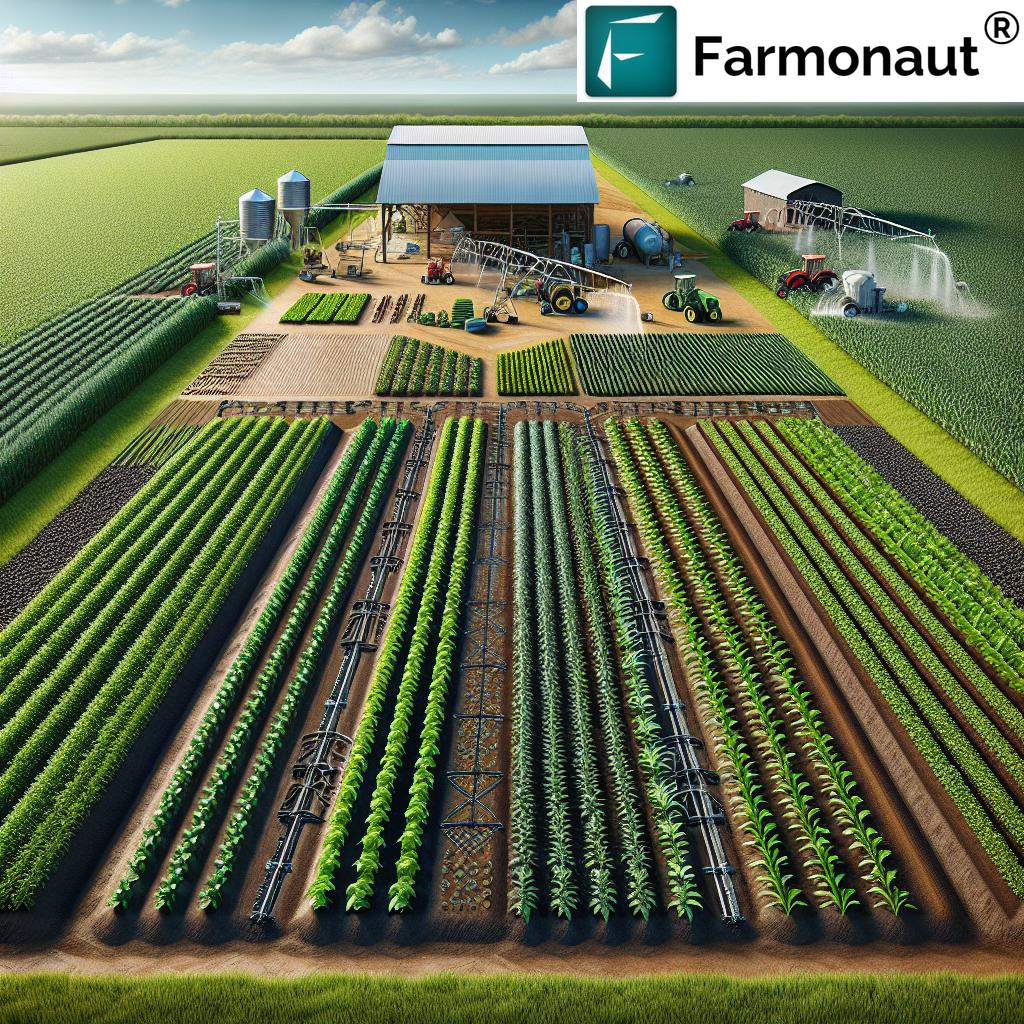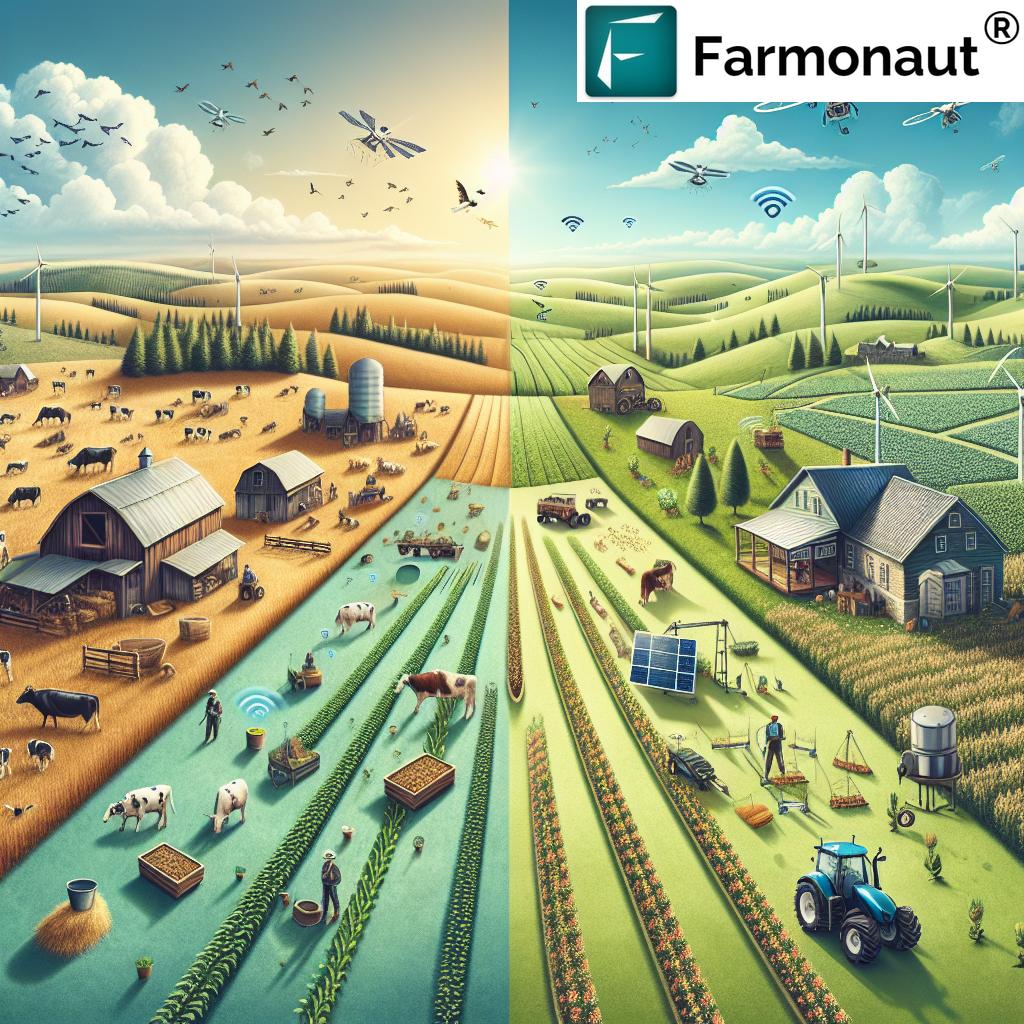Agricultural Practices to Increase Crop Yield Fast: 10 Innovative Ways to Higher Yields with Modern Technology
“Precision agriculture can boost crop yields by up to 20% through data-driven planting and fertilization techniques.”
Agricultural productivity is the fundamental driver of food security, economic growth, and sustainable development. If our goal is to increase crop yields fast, then we need a multifaceted approach that relies on the synergy of modern technology, innovative management, and eco-friendly farming practices.
In this comprehensive guide, we detail the precise and proven agricultural practices to increase crop yield fast. We’ll delve into precision agriculture technology, soil health management, efficient water management in farming, integrated pest management, and the adoption of advanced systems including drone technology, sustainable approaches, and digital tools such as those pioneered by Farmonaut. Whether you’re a farmer, an agribusiness professional, or invested in the global food demand, these insights will empower you with knowledge, actionable strategies, and up-to-date advancements in agriculture.
Table of Contents
- Why Increasing Crop Yields is a Global Imperative
- 1. Soil Health Management: The Cornerstone of Productive Agriculture
- 2. Precision Agriculture: Technology-Driven Yield Enhancement
- 3. Efficient Water Management in Farming: Optimizing a Critical Resource
- 4. Integrated Pest Management (IPM): Safeguarding Crop Health Sustainably
- 5. Crop Selection, Rotation & Intercropping: Maximizing Land Use & Productivity
- 6. Advanced Technologies & Drone Technology in Agriculture
- 7. Climate-Resilient Agriculture: Overcoming Weather Extremes
- 8. Fertilizer Management: Maximizing Nutrient Efficiency
- 9. Post-Harvest Storage Solutions: Reducing Losses, Ensuring Quality
- 10. Education and Training: Empowering Farmers for Lasting Gains
- Comparative Impact Table: Yield Gains vs. Effort & Sustainability
- How Farmonaut Empowers Modern Agriculture
- Frequently Asked Questions
- Conclusion: A Roadmap to Sustainable High Yields
Why Increasing Crop Yields is a Global Imperative
The world’s population is projected to reach nearly 10 billion by 2050, resulting in soaring food demand. To meet the growing global food demand sustainably, boosting crop yield per hectare is not just an objective—it’s a necessity. Importantly, this must be achieved while minimizing environmental impact and ensuring long-term soil and resource health.
In modern agriculture, the focus is no longer simply on volume; it’s on sustainable farming practices that balance productivity, resource management, and ecological considerations. This means we must target solutions that maximize efficiency and minimize waste.
1. Soil Health Management: The Foundation to Increase Crop Yields
Soil health management remains the cornerstone for all productive agriculture. Robust, living soil is essential for crop growth, nutrient supply, and resilience against extreme conditions. To unlock consistent yield increases, the following strategies are vital:
Implementing Conservation Techniques
- No-Till and Reduced-Till Farming: These methods minimize soil disturbance, preserving organic matter and reducing erosion. Destabilized soils lose fertility over time, leading to declining yields.
- Mulching: Applying organic mulch retains moisture, suppresses weeds, and regulates temperature. This creates optimal micro-conditions for plant growth and root development, reducing water needs and enhancing resource efficiency.
- Cover Cropping: Legumes such as clover and alfalfa fix atmospheric nitrogen, replenishing soil nutrients and improving overall soil health for the next planting cycle. They also prevent erosion and promote biodiversity.
Enhancing Soil through Biodiversity: Agroforestry
- Agroforestry Systems: Integrating trees and shrubs within croplands not only enhances biodiversity but also helps with soil conservation. The deep roots of trees aid in water and nutrient cycling, while their canopies moderate temperature and wind impact.
Balanced Nutrient Cycling and Soil Remediation
- Utilizing Organic Matter: Adding compost and green manure increases soil organic matter content. This improves soil structure, porosity, and water retention, supporting productive ecosystems.
- Remediation Practices: We can employ crop rotation and phyto-remediation to absorb contaminants and maintain a healthy growing environment for future crops.
If you’re looking to constantly track the soil moisture, temperature, and vegetation health of your fields, Farmonaut’s real-time satellite monitoring is available via mobile and web apps. This empowers farmers globally to make data-driven adjustments and enhance soil health management for long-term productivity.
2. Precision Agriculture: Harnessing Technology for Maximum Crop Yields
Precision agriculture is at the core of the technology and innovation revolution in farming. By leveraging tools such as GPS-Guided machinery, soil sampling, and advanced remote sensing, farmers can increase crop yields efficiently and minimize waste and environmental impact.
- GPS-Guided Equipment: Enables precise planting, fertilizing, and pesticide application, optimizing input usage and ensuring uniform crop stands.
- Data-Driven Irrigation Systems: Use real-time data for targeted water delivery, reducing both under- and over-watering.
- Variable Rate Application (VRA): Fertilizer and pesticide usage can be calibrated based on satellite and sensor data, ensuring each section of the field receives only what is required.
Precision agriculture technology not only boosts yield but efficiently conserves resources—essential for sustainable farming practices. Remote sensing solutions, such as those provided by Farmonaut, allow for ongoing monitoring and instant, actionable advice.
API access for precision data: For agritech developers or agribusinesses who want to integrate satellite and weather analytics into their platforms, Farmonaut provides robust API solutions and developer documentation.
“Efficient water management can reduce water usage by 30% while maintaining or increasing crop productivity.”
3. Efficient Water Management in Farming: Optimize Crop Growth with Less Waste
Water is the lifeblood of crop production. Efficient water management in farming delivers the right amount of moisture for optimal growth while preventing resource wastage—especially critical in areas facing water scarcity and climate unpredictability.
Modern Irrigation Systems
- Drip Irrigation: Delivers water directly to the plant root zone, ensuring high efficiency, minimal evaporation, and drastic water savings compared to flood irrigation.
- Sprinkler Systems: Evenly distribute water over the field, enabling precise delivery and reduced runoff. Particularly beneficial for uniformly spaced crops.
Water-Saving Techniques for Sustainable Yields
- Alternate Wetting and Drying (AWD): In rice systems, AWD involves periodic flooding and drying, which conserves water, enhances grain-filling rates, and leads to higher yields.
- Rainwater Harvesting: Collects and stores rainwater to supplement irrigation during dry periods, improving water security.
For those interested in real-time soil moisture and irrigation monitoring, Farmonaut’s platform enables farmers to track and optimize water management using remote sensing technology—essential for mitigating drought risks and improving water efficiency.
Efficient water management in farming practices are a game-changer for sustainable and high-yield crop cultivation, especially under drought-prone or rapidly changing climate scenarios.
4. Integrated Pest Management (IPM): Protect Crops & the Environment
Integrated Pest Management (IPM) represents a balanced approach to pest and disease control—crucial for yield protection while minimizing ecological harm. IPM’s strategy involves employing biological, cultural, physical, and chemical control methods only as needed, and in harmony.
- Regular Crop Monitoring: Systematic field checks spot infestations or disease onset early, allowing timely intervention and preventing large-scale losses.
- Biological Controls: Release of beneficial insects (e.g., ladybugs against aphids) reduces reliance on chemical pesticides and supports biodiversity.
- Cultural Practices: Crop rotation, proper planting times, and resistant varieties break pest and disease cycles naturally.
- Chemical Control: Used only as a last resort and with targeted, minimal application to reduce environmental impact and protect pollinators.
Farmonaut’s AI-based advisory system not only analyzes pest outbreaks but provides personalized crop protection strategies, ensuring optimal yields without sacrificing environmental sustainability. Explore more innovative crop management solutions for fast yield gains.
5. Crop Selection and Rotation: Strategic Choices for Sustainable High Yields
Selecting high-yielding, disease-resistant crop varieties and intelligent cropping systems is essential for maximizing productivity. This not only ensures a robust harvest but also keeps the farm ecosystem balanced.
- High-Yield Crop Varieties: Opt for locally adapted varieties bred for enhanced yield and disease resistance. Use certified seeds for optimal germination and vigor.
- Crop Rotation: Shifts in family (e.g., cereals followed by legumes) help break pest, disease, and weed cycles. Rotations improve soil nutrient profiles, with legumes replenishing nitrogen.
- Intercropping: Planting at least two crops together increases use efficiency, biodiversity, and yield per unit area (read more on intercropping).
Proper crop selection and rotation can boost long-term yield, reduce input costs, improve soil health, and promote sustainability.
6. Advanced Technologies: Drone Technology in Agriculture & Digital Tools
Agriculture has rapidly adopted advanced technologies to further increase crop yields. Innovations such as drone technology in agriculture and satellite monitoring are revolutionizing field management and resource optimization.
- Drones: Offer aerial mapping for plant health, pest infestation, and water stress zones. They enable precision spraying—applying fertilizer or pesticide exactly where needed, reducing labor and resource costs (more on drone adoption).
- Satellite Imagery: Provides holistic and real-time crop monitoring. With platforms like Farmonaut, farmers get access to vegetation indices (like NDVI), soil moisture maps, and yield estimation tools, allowing targeted action for fast yield improvement.
- AI-Based Decision Systems: Predict weather, disease, and growth stages for proactive response and increased resilience.
Adopting these digital solutions empowers farmers to optimize input use, minimize waste, and improve farm decision-making for higher yields.
7. Climate-Resilient Agriculture: Building Future-Proof Farming Systems
Extreme weather, from drought to floods, is now a reality. Climate-resilient agriculture practices ensure that crop yields remain high, even with unpredictable weather.
Developing and Using Climate-Resilient Crop Varieties
- Drought and Heat-Resistant Varieties: These crops maintain yield under water-stress and high temperature scenarios, thus increasing farm security and resilience.
Optimizing Water & Resource Use
- Deficit Irrigation: This technique intentionally provides less water than full crop requirement, boosting water-use efficiency while generally maintaining yields.
- Diverse Planting Times: Adjusting sowing and transplanting times shields crops from peak stress or pest attacks.
For growers looking for new, verified climate-resilient solutions, Farmonaut’s advisory system offers customized recommendations based on weather and crop growth analysis—pivotal for climate adaptation.
Enhance Supply Chain Trust with Farmonaut’s Blockchain Product Traceability
Streamline Crop Loans & Insurance with Satellite Verification
Optimize Machinery & Logistics with Fleet Management for Agribusinesses
Manage Large Plantations Efficiently – Learn About Large-Scale Farm Management Solutions
8. Fertilizer Management: Achieving Optimal Plant Nutrition with Minimal Waste
Proper fertilizer management is fundamental for high yield without causing nutrient runoff or soil degradation.
- Soil Testing: Conduct regular soil sampling to identify nutrient deficiencies and excesses. This forms the basis for targeted fertilizer application, optimizing cost while improving plant growth.
- Precise and Variable-Rate Application: Use advanced spreaders or drone spraying to apply fertilizers only where needed, minimizing waste and environmental risks.
- Incorporation of Organic Fertilizers: Compost, manure, and green manure add organic matter, replenish nutrients, and support microbial health for a more resilient farming system.
Farmonaut’s platform allows for the ongoing monitoring of nutrient stress and provides digital advisory on optimal fertilizer use, ensuring every crop receives the support it needs for strong, consistent yields.
9. Post-Harvest Storage Solutions: Protecting Harvest Quality & Minimizing Losses
Improved post-harvest management is essential. Losses due to poor handling, delays, and suboptimal storage significantly cut into farm profits and global food supply.
- Proper Drying: Immediate and uniform drying of harvested crops prevents mold, maintains quality, and extends shelf life.
- Controlled Storage Environments: Cold storage, hermetic bags, and modified atmosphere chambers help maintain nutrients and reduce spoilage. Technologies such as Farmonaut’s digital traceability ensure complete supply chain transparency from farm to market.
- Efficient Processing: Mechanized shelling, grading, and packaging maintain standards and allow access to profitable markets.
Modern post-harvest storage solutions are a critical link in maximizing actual delivered yield, not just harvested crops.
10. Education and Training: Empowering Farmers for Fast, Sustainable Gains
Continuous education and training remain vital to achieving and sustaining high yields. Agricultural best practices, technology adoption, and market trends evolve rapidly—staying current is essential.
- Extension Services: Local or digital advisory services keep farmers updated on pest outbreaks, weather anomalies, or subsidy opportunities.
- Peer Education: Knowledge sharing among farming communities accelerates adoption of innovative and efficient techniques.
- Online Training Modules: Through platforms like Farmonaut, farmers gain tailored learning opportunities, from satellite data interpretation to resource management.
Strong farmer education is the foundation of resilient, adaptive farming that meets future food needs and ensures sustainable management of resources.
Comparative Impact Table: Modern Agricultural Practices, Yield Gains, and Sustainability Ratings
| Practice/Technique | Estimated Yield Increase (%) | Implementation Complexity | Sustainability Rating (1-5) |
|---|---|---|---|
| Precision Irrigation (Drip/Sprinkler) | +10% to +30% | Medium | 5 |
| Drone-Based Monitoring & Precision Spraying | +5% to +25% | High | 4 |
| Soil Health Management (No-till, Mulching, Cover Cropping, Agroforestry) | +8% to +20% | Low/Medium | 5 |
| Remote Sensing & Real-Time Monitoring | +8% to +18% | Medium | 5 |
| Data-Driven Fertilizer Application | +7% to +22% | Medium | 4 |
| Integrated Pest Management (IPM) | +5% to +15% | Medium | 5 |
| High-Yield, Disease-Resistant Crop Varieties | +10% to +35% | Low | 3 |
How Farmonaut Empowers Modern Farmers with Technology
At Farmonaut, our mission is to make precision agriculture technology accessible and affordable for all farmers worldwide. Our web, Android, and iOS platforms provide the following leading-edge solutions:
- Satellite-Based Crop Health Monitoring: Real-time insights on NDVI, soil moisture, and more to guide every farm decision.
- AI-Driven Jeevn Advisory: Actionable recommendations for irrigation, fertilizer, pest management, and planting schedules—customized to your field’s latest satellite data and local weather.
- Blockchain Traceability: Ensures transparency and trust in the agricultural supply chain, beneficial for crop certification and premium market access.
- Resource & Fleet Management: Optimize your machinery, reduce operational costs, and better manage agricultural logistics.
- Carbon Footprinting: Track your environmental impact in real-time and adopt more sustainable farming practices.
- Crop Loan & Insurance Verification: Faster, fraud-resistant farmer finance with satellite proof.
Start optimizing your farm or agribusiness today! Download the Farmonaut app on your preferred device, or access our platform through any web browser.
Frequently Asked Questions (FAQ) on Increasing Crop Yield Fast
- Q1: What is the single most effective way to increase crop yield quickly?
-
There’s no universal answer, but a combination of precision agriculture technology, soil health management, efficient water use, and optimized fertilizer strategies will provide the fastest and most sustainable yield gains.
- Q2: How do precision agriculture tools really benefit farmers?
-
By leveraging real-time data from satellites, sensors, and drones, precision agriculture helps apply inputs (water, fertilizers, pesticides) only where needed, reducing waste and increasing both crop yield and profitability.
- Q3: Are sustainable practices like no-till, cover cropping, and IPM economically viable for smallholders?
-
Yes, these practices actually reduce input costs over time and improve soil health, which translates to higher resilience and yields in the long term—even for smallholder farms.
- Q4: How can drone technology in agriculture improve yield?
-
Drones offer rapid, detailed mapping for crop health, pest outbreaks, and nutrient issues. They also enable precision spraying to target treatments and reduce labor, input waste, and overall costs.
- Q5: What role does post-harvest management play in increasing farm income?
-
Proper storage, drying, and handling drastically reduce losses and maintain product quality, ensuring a bigger share of the harvest reaches high-value markets.
- Q6: Why is farmer education so critical for boosting yield?
-
Without up-to-speed agricultural knowledge and training, many yield-boosting innovations go underutilized. Continuous education ensures best practices, new technologies, and market strategies are adopted on time.
- Q7: Where can I get reliable farm advisory based on my field’s actual condition?
-
Digital platforms like Farmonaut provide AI-driven recommendations tailored to your farm’s real-time satellite analytics, helping you make informed decisions for higher yields.
Conclusion: Sustainable Yield Increases are Within Every Farmer’s Reach
In conclusion, increasing crop yield fast is best achieved through a blend of technology-driven, data-enabled, and ecologically sound agricultural practices. From the cornerstone of soil health management to innovative precision agriculture technology, farmers now have more tools than ever to lift productivity, cut waste, and promote sustainable farming practices.
Digital advancements—enabled by platforms like our own at Farmonaut—now democratize access to real-time crop monitoring, advisory systems, and blockchain traceability. These empower individual farms and large agribusinesses alike to make actionable decisions, reduce costs, enhance soil and water management, and meet the future of global food demand sustainably.
Whether you’re looking to optimize inputs, boost resilience against climate extremes, or streamline your post-harvest processes, the practices, technologies, and resources detailed in this guide are proven pathways to achieving higher, stable, and sustainable farm yields.
Ready to start your journey with precision agriculture and innovative farm management? Download Farmonaut today on Android, iOS, or web!












